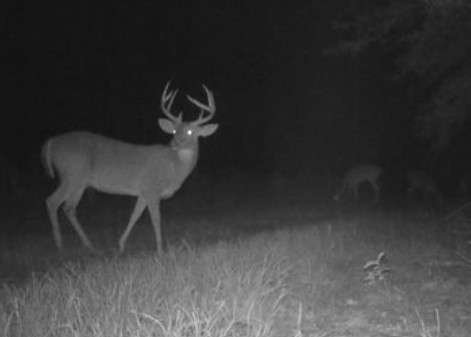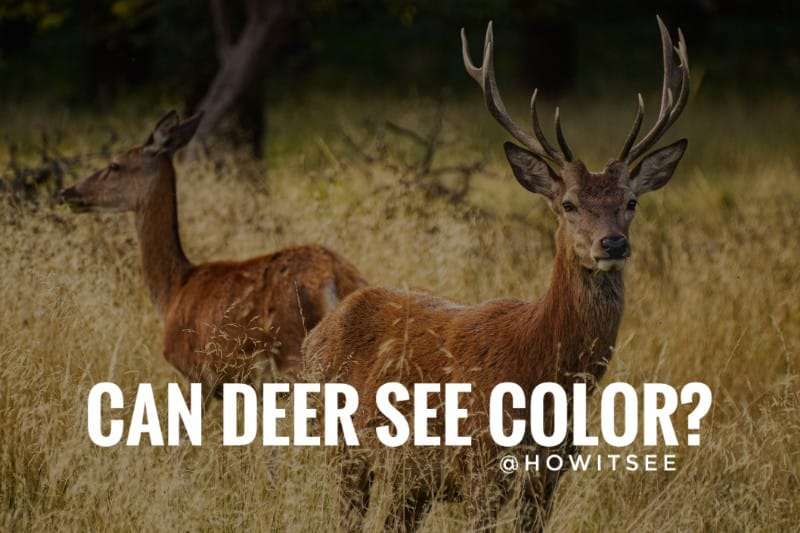Deer, also known as true deer, are from the Cervidae family, which later on distinguished into two groups, the Cervinae, and the Capreolinae. Many peoples, especially hunters, have doubts about how deer perceive colors or how deer see the world. So, if you have the query, then you have landed on the correct page.
The answer to the question, “Can deer see color” is: Deer can see colors but cannot distinguish it much as humans. According to the study, deer are dichromats, resulting in the low differentiation of the colors. They can see the blue part of the spectrum best with a shorter wavelength and higher energy. And some green-yellow parts of the spectrum with middle wavelength.
However, the cones and rods in their eyes react least to the orange-red part of the spectrum due to being dichromatic.
Later in this post, we have explained in detail how deer see color and the world as compared to humans. So that you will get a brief knowledge on this topic, let’s begin.
Can Deer see color?
Deer can see colors but have a relatively low-resolution vision. It means they categorize colors differently. According to George Gallagher, professor of animal science at Berry College, deer perceive the longer wavelength colors like reds oranges as yellow tones and the middle wavelength colors like green into the shades of gray to yellow.
Deer don’t have a “Yellow”/ Ultraviolet filter in their lens. It helps them see the blue part of the visible spectrum in a much better way than us. Not only this, they can comprehend ultraviolet light, which helps to see in low light.
However, due to the lack of UV filters, their eyes are much more vulnerable to the sun. Therefore, deer can see much better at night as compared to the day.
Below we have attached the image of the electromagnetic spectrum for better understanding.

According to the research it is listed that there are 51 species of deer. However, maximum of them have the same type of vision. As justified by Cohen, deer are most active during dawn and dusk because, at that time, the blue-spectrum colors play the majority of the role in the surroundings. They can see perfectly at that time.
Some hunters wear camouflage clothing because deer don’t have the ability to distinguish color shades as well as humans, appearing them as big objects.
In accordance with the study, scientists estimated that deer have 20/100 vision. “It means the details of the surroundings that deer see at 20 feet is what a normal human can see back to 100 feet.”
But they can’t adjust their eyes to objects at far distances giving them less visual clarity.
In conclusion, deer are dichromats and can react to only two colors, i.e., blue and green, but in the absence of a yellow filter, they can notice UV lights too.
Are Deer color blind?
Deer are not completely color blind. They have dichromatic vision, which means their eyes are sensitive to blue and green colors. They primarily see the world in blue, dull yellow, and gray shades. On the other hand, humans are trichromatic and can perceive blue, green, and red colors from 380 nm to 720 nm wavelength.
The human eye has the ability to distinguish small, medium, and large wavelength colors. But deer have a large wavelength cone missing. Therefore, they sense the colors nearly up to 520 nm wavelength. And it leads them to see the world in the shades of blue, yellow, and gray.

Image Source | North American Whitetail
Although they cannot distinguish the color variations like humans, due to big eyes and lack of UV filter, they can perceive UV light and see much better at night. With the ability to perceive UV light, they can recognize the light below 380 nm wavelength, which is impossible for humans.
Deer eyes are concentrated more on rods rather than cones. Rods in the eyes helps to distinguish the world in low-light condition, whereas cones in the eyes assist in recognizing millions of color shades.
Humans have more cones, whereas deer have more rods in their eyes, which helps to see much better in the dark. Not only this, but they also have tapetum lucidum, a thin reflective tissue behind their retina to grant them night vision.
After going through this explanation, you can say that deer can see color but cannot see the millions of color shades; hence they are not completely colorblind. But in exchange for the color vision, they have night vision that helps them survive in the dark.
Later in this post, we have compared deer vision with human vision in an illustrative way.
Can Deer see green light at night?
Yes, deer can see a green light at night but in the form of gray shades. Deer are dichromatic. It means the rods and cones in their eyes can react to blue-green colors. It shows that they can perceive green color. However, they cannot distinguish it as same as humans. They see it in the form of gray shades.
Unlike humans, deer have tapetum lucidum. It is a small film of reflective tissue present inside the eyes of many nocturnal animals, which helps to glimpse at night. If you flash a light on deer at night, their eyes will glow.

It shows the availability of tapetum lucidum. The basic principle of tapetum lucidum is to reflect even the slightest of light back to the retina, allowing the user to glimpse in low light conditions. Deer have night vision and see much better in the dark compared to humans.
Also, their pupils are ten times larger and comprise more rods than humans having fewer cones. It allows them to perceive even the slightest of light coming from the moon or stars to glimpse in the dark.
Can Deer see white?
Deer can sense white light. The rods and cones among deer are very sensitive to white and yellow light, and they can sense them. Therefore, many hunters prefer not to use white light during hunting at night.
Not only deer but many nocturnal animals are sensitive to white light. They have pupils, which helps them see well at night by allowing maximal light exposure. Hence that’s why they are responsive to light.
Deer Vision vs. Human Vision
| Human Vision | Deer Vision |
| Trichromats (Sensitive to blue-green-red) | Dichromats (Sensitive to blue-green) |
| Can distinguish millions of shades | Cannot distinguish millions of shades |
| Cannot see Ultraviolet light | Can see ultraviolet light |
| Cannot see in dark | Can see in dark |
Here we conclude our article on “Can deer see color,” along with other minor queries. We hope you like it. We will be back with another post. Till then, stay tuned with us and read the FAQs given below.
Frequently Asked Questions-
Q1. What colors can Deer see?
Ans. Deer can see the blue-green part of the color spectrum.
Q2. Can Deer see orange?
Ans. Deer can see orange but are very less sensitive to it. It means they cannot differentiate it.
Q3. Can Deer see red?
Ans. Deer are very less sensitive to red and cannot differentiate it.
Q4. Can Deer see gray?
Ans. Yes, deer can see grey-shades.
References-
Research done by by Don E. Wilson and DeeAnn M. Reeder (Johns Hopkins Press, 2005), Mammal Species of the World, 3rd Edition
Facts About Deer Vision and How It Can Help Us Succeed | By North American Whitetail
SCIENTIFIC FACTS ABOUT HOW DEER SEE AND HEAR | By Texa Hunter products
Also Read:

Meet Abhidept (nickname Monty), the visionary founder of How It See, being an engineering student, he’s fueled by an insatiable curiosity about the world around him. He is captivated by an eclectic correlation between animal groups, science, and nature, and this fascination drives his quest for understanding.
After completing his degree, he’s set on a mission to delve deep into the realm of nature, accumulating knowledge to share with you through his writing. In the meantime, he loves to watch anime and read anime.
